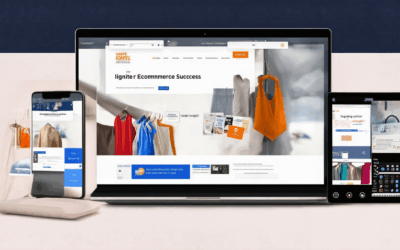In the ever-evolving landscape of digital innovation, staying ahead of the curve requires mastering the latest trends and best practices in web design. As we step into 2024, the demand for websites that not only look great but also deliver exceptional user experiences continues to rise. This guide delves into the essential strategies that every modern designer and developer should know, ensuring your work remains future-proof and adaptable to changing demands. From optimizing user experience to leveraging cutting-edge technologies, discover how to create websites that resonate with audiences and stand out in a competitive market. Whether you’re refining existing sites or building new ones, understanding these best practices is crucial for long-term success.
Key Takeaways
– Responsive Design: Ensure your website adapts seamlessly to all devices, enhancing user experience across mobile, tablet, and desktop.
– User-Centric UX: Prioritize intuitive navigation, fast load times, and clear visual hierarchy to deliver an effortless user experience.
– Performance Optimization: Speed up your site by compressing images, leveraging caching, and minimizing scripts—aim for a Google PageSpeed Insights score of 90+.
– Accessibility: Design for everyone by adding alt texts, using semantic HTML tags, and ensuring keyboard navigation for universal access.
– Cross-Browser Compatibility: Test your site across major browsers like Chrome, Firefox, Safari, and Edge for consistent rendering and functionality.
– SEO Integration: Optimize your site with meta tags, alt texts, and structured data to boost search engine visibility and rich snippets.
– Modern UI/UX Trends: Adopt minimalist designs, micro-interactions, and flat aesthetics to create a clean, engaging, and future-proof interface.

The Four Cs of Website Design
The Four Cs of website design are essential principles that guide the creation of effective and user-friendly websites. These Cs stand for Consistency, Continuity, Context, and Complementary.
1. Consistency
Consistency ensures that your website maintains a uniform look, feel, and user experience across all devices and platforms. This includes branding, typography, color schemes, and navigation patterns. Consistency helps users easily navigate your site and builds brand recognition.
2. Continuity
Continuity refers to the seamless transition between pages and interactions on your website. It includes smooth animations, intuitive navigation, and a cohesive flow that keeps users engaged. Ensuring continuity helps reduce frustration and enhances the overall user experience.
3. Context
Context is about understanding the purpose of each page and how it fits into the larger user journey. Context-driven design considers factors like user intent, device usage, and platform-specific behaviors. For example, a mobile-optimized design prioritizes touch-friendly elements and limited screen space.
4. Complementary
Complementary design focuses on how elements work together to create harmony and balance. This involves considering the relationship between colors, typography, spacing, and other design elements. A complementary design ensures that no single element overwhelms the user or detracts from the overall experience.
By focusing on these four Cs, designers can create websites that are not only visually appealing but also functional, user-centric, and adaptable across various platforms.
For further reading, explore this guide on responsive design, which is a key aspect of ensuring continuity and context in your website’s user experience.
Best Practices for Web Page Design
Designing effective web pages involves a combination of creativity, usability, and technical expertise. Below are key principles to guide you toward creating web pages that engage users, perform well in search engines, and deliver a seamless experience across devices.
- User-Centric Design: Prioritize user needs by ensuring your site is accessible, easy to navigate, and provides clear value. Use simple, readable fonts and spacing to reduce cognitive load.
- Mobile Responsiveness: Optimize your design for mobile devices, as they now account for over half of all web traffic. Use responsive layouts and touch-friendly buttons.
- Content Strategy: Craft high-quality, relevant content tailored to your audience. Use clear headings, bullet points, and visuals to enhance readability. Incorporate keywords naturally without stuffing.
- Performance Optimization: Minimize page load times by leveraging browser caching, optimizing images, and using efficient code. Slow-loading sites often lead to higher bounce rates.
- Accessibility: Ensure your site is usable by everyone, including those with disabilities. Add alt texts for images, use semantic HTML tags, and provide keyboard navigation.
- Cross-Browser Compatibility: Test your design across major browsers like Chrome, Firefox, Safari, and Edge to ensure consistency and functionality.
- Continuous Testing and Feedback: Regularly test your pages with real users and gather feedback to identify areas for improvement. A/B testing can help optimize key elements like CTAs.
By following these guidelines, you can create web pages that not only look great but also drive engagement, improve user experience, and achieve better search engine rankings. Always keep your audience’s needs at the forefront of your design process.

The Future of Web Design
The future of web design is bright and full of opportunities, driven by technological advancements and evolving user needs. Here are some key trends and predictions that suggest a promising trajectory for web designers:
- Augmented Reality (AR) and Virtual Reality (VR):
As AR and VR technologies become more mainstream, web designers will play a crucial role in creating immersive online experiences. These technologies can transform how products are visualized, enabling users to interact with 3D models or virtual environments directly within web browsers. This shift will require designers to master new tools and techniques to optimize these experiences. - AI-Powered Design Tools:
Artificial intelligence is revolutionizing the design process, from generating initial concepts to refining layouts. AI tools can analyze vast amounts of data to suggest design patterns, optimize color schemes, and even predict user behavior. While these tools may automate certain tasks, they will also create new opportunities for creative expression and innovation among designers. - Focus on Accessibility:
With an increasing emphasis on inclusivity, web designers will continue to prioritize accessibility. Features like screen readers, keyboard navigation, and high-contrast modes will become standard, ensuring that websites are usable by everyone, regardless of ability. This trend aligns with broader societal values and will likely dominate design practices moving forward. - Sustainability in Design:
Environmental concerns are shaping how web designers approach their work. Practices like using reusable CSS, minimizing file sizes, and adopting eco-friendly development methods are becoming common. Designers are also exploring ways to reduce the carbon footprint of their projects, contributing to a more sustainable digital landscape. - Cross-Browser Compatibility and Progressive Enhancement:
Ensuring websites work seamlessly across all browsers and devices remains a cornerstone of web design. As technology evolves, designers will need to adapt to new standards and frameworks that enhance user experiences while maintaining consistency. - Voice Search Optimization:
With voice search becoming a primary method of interaction, web designers must optimize for voice interfaces. This involves structuring content with natural language processing in mind, ensuring that websites can be easily navigated through voice commands. - Responsive Design Evolution:
Responsive design continues to be a critical skill for web designers. As screens get larger and more varied, mastering how designs adapt to different screen sizes and orientations will remain essential. - Branding and User Experience Integration:
The lines between branding and user experience (UX) design are blurring. Designers will need to tell compelling brand stories while ensuring that the user experience aligns with the brand’s identity. This integration will drive engagement and loyalty. - Globalization and Cultural Adaptation:
Web designers are increasingly tasked with creating content that resonates globally. Understanding cultural nuances and adapting designs accordingly will become a key part of the job, facilitated by tools like localization plugins and AI-driven translation services. - Ethical Considerations:
Ethical considerations, such as privacy and data protection, will influence design decisions. Designers will need to balance aesthetics with functionality, ensuring that user data is secure and that privacy policies are clearly communicated.
The future of web design is undetermined, but the direction suggests a field that is constantly evolving, offering endless possibilities for creativity and innovation. By embracing emerging technologies, prioritizing user needs, and staying attuned to global trends, web designers will continue to shape the digital landscape in meaningful ways.

Best Practices in Web Design for 2024
Web design continues to evolve with each passing year, bringing new trends and strategies that aim to enhance user experience, improve functionality, and increase engagement. Here are the most important best practices for web design in 2024:
- Responsive Design:** Ensure your website is fully responsive, providing optimal viewing experiences across all devices, including mobile phones, tablets, and desktop computers. Use flexible layouts and media queries to adapt content dynamically.
- User Experience (UX):** Prioritize user-centric design principles to maximize usability and satisfaction. Simplify navigation, reduce load times, and provide clear visual hierarchy to guide users effortlessly through your site.
- Performance Optimization:** Speed is critical. Compress images, leverage browser caching, and minimize unnecessary scripts to ensure fast loading times. Aim for a score of 90 or higher on Google PageSpeed Insights.
- Accessibility:** Make your website accessible to everyone, including individuals with disabilities. Add alt texts for images, use semantic HTML tags, and implement ARIA labels for interactive elements.
- Cross-Browser Compatibility:** Test your designs across major browsers like Chrome, Firefox, Safari, and Edge. Use cross-browser testing tools to ensure consistent rendering and functionality.
- SEO Integration:** Optimize your site for search engines by incorporating meta tags, alt texts, and structured data. Use schema markup to enhance rich snippets and improve your site’s visibility in search results.
- UI/UX Design Trends:** Stay updated with the latest trends in UI/UX design, such as flat design, micro-interactions, and voice user interfaces. Experiment with these elements to create a modern and engaging user experience.
To implement these best practices effectively, consider using tools and frameworks like Adobe Muse for design and prototyping, or Bootstrap for responsive web development.
By following these guidelines, you can create a website that not only looks great but also delivers exceptional user experiences and performs exceptionally well in terms of speed and SEO.
Best Practices in Web Design for 2024
In 2024, web design continues to evolve rapidly, driven by changing user behaviors, technological advancements, and shifting design trends. Here are the most critical best practices to ensure your website stands out and delivers an exceptional user experience:
- Responsive Design:** Prioritize responsive design to ensure seamless viewing experiences across all devices, from mobile phones to desktop computers. Use CSS Grid and Flexbox for modern layouts and consider PWAs (Progressive Web Apps) for enhanced functionality.
- User Experience (UX) Optimization:** Focus on creating intuitive navigation, fast load times, and visually appealing interfaces. Consistency in design elements like color schemes and typography helps maintain brand identity across platforms.
- Accessibility Matters:** Design with accessibility in mind by incorporating features like keyboard navigation, screen reader compatibility, and alt texts for images. Ensure your site meets WCAG standards to cater to a broader audience.
- SEO Integration:** Optimize your site for search engines by implementing meta tags, alt texts, and structured data. Use tools like Yoast SEO to automate SEO tasks and ensure your content is keyword-rich without sacrificing readability.
- Minimalist and Clean Design:** Embrace simplicity with minimalist layouts that highlight content and reduce cognitive load. Use negative space effectively and avoid clutter to enhance user focus.
- Cross-Browser Compatibility:** Test your designs across major browsers like Chrome, Firefox, Safari, and Edge to ensure consistency. Use browser-specific tools and frameworks to mitigate issues.
- Performance Optimization:** Speed is key! Implement techniques like lazy loading for images, code minification, and caching strategies to reduce load times. Consider server-side rendering (SSR) for static sites to improve performance.
- Content Strategy:** Develop a content strategy that aligns with your target audience’s interests and goals. Use data analytics to refine your approach and focus on creating engaging, shareable content.
By adhering to these best practices, you can create a website that not only looks great but also performs exceptionally well, driving better engagement and conversions. Stay updated with the latest trends and continuously test your designs to meet evolving user expectations.

Best Practices in Web Design for 2024
- Responsive Design: Ensure your website is fully responsive, adapting seamlessly to various screen sizes and devices. Use frameworks like Figma or Adobe XD to create flexible layouts.
- User Experience (UX): Prioritize intuitive navigation, fast load times, and seamless interactions. Implement A/B testing to optimize conversion paths and personalize user experiences.
- Performance Optimization: Optimize images with tools like ImageOptim or Squoosh, leverage browser caching, and use lazy loading for videos and heavy assets to reduce page load times.
- Accessibility: Make sure your website is accessible to everyone, including those with disabilities. Add alt texts for images, use semantic HTML tags, and ensure keyboard navigation works smoothly.
- Cross-Browser Compatibility: Test your site across major browsers like Chrome, Firefox, Safari, and Edge. Use tools like BrowserStack to automate cross-browser testing.
- SEO Integration: Embed structured data using schema markup, optimize meta descriptions, and ensure your site is mobile-first to improve search engine rankings.
- UI/UX Design Trends: Adopt minimalistic design approaches, micro-interactions, and flat design principles to keep your interface clean and modern. Use CSS Grid and Flexbox for layout.
By following these best practices, you can create a website that not only looks great but also delivers exceptional user experiences and performs exceptionally well in 2024 and beyond.




0 Comments